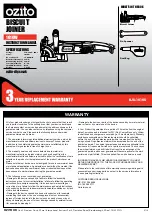
OPERATION
5. PRE-OPERATION CHECKS
4. ADJUSTING THE ANGLE & HEIGHT
1 Ensure the joiner’s plunge is
moving freely along its rails.
2 Check the disc carefully for
cracks or damage and replace
in necessary.
3 Ensure the dust bag is secure
and the zip is closed.
4 Make sure the cutting depth,
height and angle have been
set to match the desired cut
and material thickness.
5 Clamp the workpiece securely
so that it will not move during
the cut.
Adjusting the Cutting Angle
Adjusting the height of the fence
1 Loosen the bevel locking
knob anti-clockwise.
1 Loosen the height locking
knob.
3 Retighten the bevel locking knob securely by rotating it clockwise.
2 Move the fence to the desired
angle on the bevel adjustment
scale.
2 Adjust the fence to the
desired height using the
height adjustment scale.
3 Retighten the height locking knob securely by rotating it clockwise.
4 Perform a visual check to ensure the centre of the blade lines up
with the centreline you marked on the face of the workpiece and
re-adjust if necessary.
Note:
The indicator on the height adjustment scale measures the
distance between the face of the fence and the centre of the blade.
Note:
After completing this operation, double check the cutting angle to
ensure the face of the fence is flush with the workpiece.
When using your biscuit joiner to make mitred joins, it is necessary to
change the angle of cut to match the bevel for an accurate join.
The height should correspond to half of the material thickness of the
workpiece taking into account the width of the blade. The groove for
the biscuit should always be in the middle of the workpiece, unless you
are joining thick workpieces, where multiple adjacent biscuit joins are
sometimes used.
WARNING!
ENSuRE ThE BISCuIT JOINER IS SWITChEd
Off ANd dISCONNECTEd fROM ThE pOWER SuppLy
BEfORE pERfORMING ANy Of ThE fOLLOWING TASkS.










